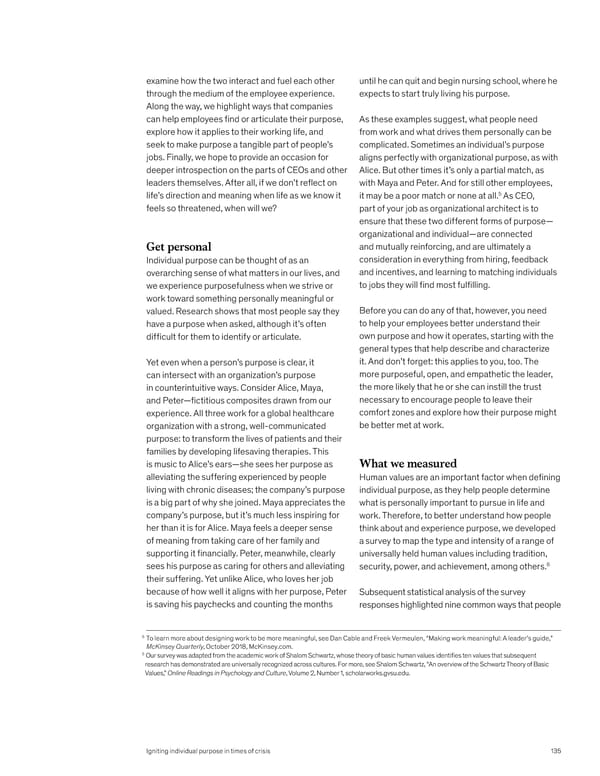examine how the two interact and fuel each other until he can quit and begin nursing school, where he through the medium of the employee experience. expects to start truly living his purpose. Along the way, we highlight ways that companies can help employees find or articulate their purpose, As these examples suggest, what people need explore how it applies to their working life, and from work and what drives them personally can be seek to make purpose a tangible part of people’s complicated. Sometimes an individual’s purpose jobs. Finally, we hope to provide an occasion for aligns perfectly with organizational purpose, as with deeper introspection on the parts of CEOs and other Alice. But other times it’s only a partial match, as leaders themselves. After all, if we don’t reflect on with Maya and Peter. And for still other employees, life’s direction and meaning when life as we know it it may be a poor match or none at all.5 As CEO, feels so threatened, when will we? part of your job as organizational architect is to ensure that these two different forms of purpose— organizational and individual—are connected Get personal and mutually reinforcing, and are ultimately a Individual purpose can be thought of as an consideration in everything from hiring, feedback overarching sense of what matters in our lives, and and incentives, and learning to matching individuals we experience purposefulness when we strive or to jobs they will find most fulfilling. work toward something personally meaningful or valued. Research shows that most people say they Before you can do any of that, however, you need have a purpose when asked, although it’s often to help your employees better understand their difficult for them to identify or articulate. own purpose and how it operates, starting with the general types that help describe and characterize Yet even when a person’s purpose is clear, it it. And don’t forget: this applies to you, too. The can intersect with an organization’s purpose more purposeful, open, and empathetic the leader, in counterintuitive ways. Consider Alice, Maya, the more likely that he or she can instill the trust and Peter—fictitious composites drawn from our necessary to encourage people to leave their experience. All three work for a global healthcare comfort zones and explore how their purpose might organization with a strong, well-communicated be better met at work. purpose: to transform the lives of patients and their families by developing lifesaving therapies. This is music to Alice’s ears—she sees her purpose as What we measured alleviating the suffering experienced by people Human values are an important factor when defining living with chronic diseases; the company’s purpose individual purpose, as they help people determine is a big part of why she joined. Maya appreciates the what is personally important to pursue in life and company’s purpose, but it’s much less inspiring for work. Therefore, to better understand how people her than it is for Alice. Maya feels a deeper sense think about and experience purpose, we developed of meaning from taking care of her family and a survey to map the type and intensity of a range of supporting it financially. Peter, meanwhile, clearly universally held human values including tradition, sees his purpose as caring for others and alleviating 6 security, power, and achievement, among others. their suffering. Yet unlike Alice, who loves her job because of how well it aligns with her purpose, Peter Subsequent statistical analysis of the survey is saving his paychecks and counting the months responses highlighted nine common ways that people 5 To learn more about designing work to be more meaningful, see Dan Cable and Freek Vermeulen, “Making work meaningful: A leader’s guide,” McKinsey Quarterly, October 2018, McKinsey.com. 5 Our survey was adapted from the academic work of Shalom Schwartz, whose theory of basic human values identifies ten values that subsequent research has demonstrated are universally recognized across cultures. For more, see Shalom Schwartz, “An overview of the Schwartz Theory of Basic Values,” Online Readings in Psychology and Culture, Volume 2, Number 1, scholarworks.gvsu.edu. Igniting individual purpose in times of crisis 135
 What Now? Page 136 Page 138
What Now? Page 136 Page 138